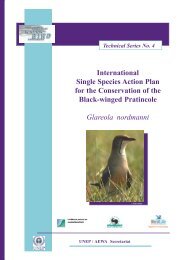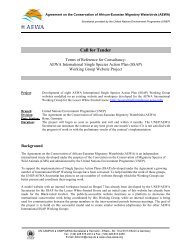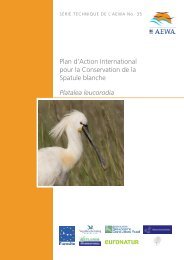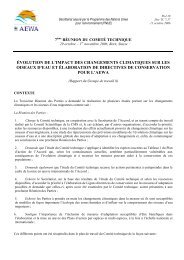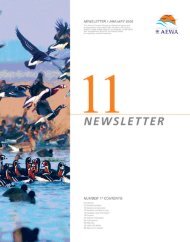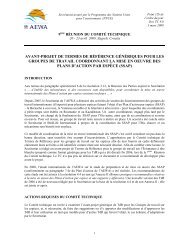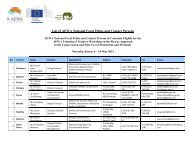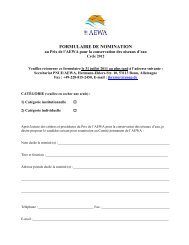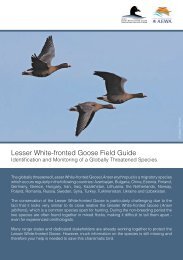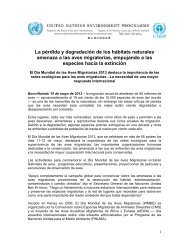5 SESSION OF THE MEETING OF THE PARTIES - AEWA
5 SESSION OF THE MEETING OF THE PARTIES - AEWA
5 SESSION OF THE MEETING OF THE PARTIES - AEWA
You also want an ePaper? Increase the reach of your titles
YUMPU automatically turns print PDFs into web optimized ePapers that Google loves.
AGREEMENT ON <strong>THE</strong> CONSERVATION <strong>OF</strong><br />
AFRICAN-EURASIAN MIGRATORY WATERBIRDS<br />
Doc: <strong>AEWA</strong>/MOP.Inf.5.9<br />
Agenda item: 16<br />
Original: English<br />
Date: 30 April 2012<br />
5 th <strong>SESSION</strong> <strong>OF</strong> <strong>THE</strong> <strong>MEETING</strong> <strong>OF</strong> <strong>THE</strong> <strong>PARTIES</strong><br />
14 – 18 May 2012, La Rochelle, France<br />
“Migratory waterbirds and people - sharing wetlands”<br />
<strong>THE</strong> WINGS OVER WETLANDS (WOW) UNEP-GEF AFRICAN-EURASIAN FLYWAYS<br />
PROJECT AND POST-WOW PARTNERSHIP ACTIVITIES 1<br />
Prepared by Dr Gerard C. Boere, former Chair of the WOW Steering Committee<br />
At the first Session of the Meeting of the Parties to <strong>AEWA</strong> (MOP1), in November 1999, in Cape Town,<br />
South Africa, the Dutch Government, the <strong>AEWA</strong> Interim Secretariat and Wetlands International (WI)<br />
continued the discussions, which had started in 1998, with stakeholders such as the United Nations<br />
Environment Programme (UNEP), on the subject of a possible large-scale Global Environmental Facility<br />
(GEF) project to support <strong>AEWA</strong> activities. These discussions were based on the results of a GEF/PDF-A<br />
phase funded by The Netherlands, which were presented to MOP1, and which ultimately led to the<br />
development of the widely-known Wings Over Wetlands (WOW) project (www.wingsoverwetlands.org).<br />
The WOW project became a reality through a GEF contribution and substantial co-funding from the German<br />
Government (as pledged at MOP2), as well as from a number of other governments and organizations (see<br />
the draft Resolution <strong>AEWA</strong>/MOP5 DR4 Implementation of the Wings Over Wetlands (WOW) UNEP-GEF<br />
African-Eurasian Flyways Project and Post-WOW Prospects and the WOW website for more details).<br />
During the period between the first discussions on the project in 1998, the final approval by GEF in 2004, the<br />
launch in 2006 and the formal closure of the project at the end of 2010, the WOW project has contributed<br />
significantly to establishing the flyway approach on the political and conservation agenda of the African-<br />
Eurasian region; not only for migratory waterbirds, but for migratory birds in general.<br />
The project has turned a vision into reality, a vision, which primarily focused on firmly implanting the<br />
flyway conservation approach into the thinking and practice of all those involved: governments, NGO’s,<br />
local stakeholders etc., and on developing tools that would stimulate flyway conservation in the long term.<br />
Thus the comprehensive Flyway Training Kit (FTK) was developed under WOW and launched in 2010.<br />
English, French, Russian and Arabic language versions of the FTK now are available 2 .<br />
The FTK serves as a resource for both site managers and policy makers alike. The WOW Team has received<br />
positive reactions from all over the world on this project output and plans are being developed to produce<br />
similar manuals for other flyway regions. Regional training of trainers (ToT) courses were organised for the<br />
Middle East region in Jordan, for West Africa in Cameroon and Central Asia in Kazakhstan between 2009<br />
and 2010. Use of the FTK at national level has taken place through the organization of a training course in<br />
Mozambique and incorporation in university course work in Saudi Arabia. Unfortunately the necessary<br />
resources are lacking to roll out a full and long-term training programme for East and Southern Africa and<br />
other regions; however some projects have started or are under development (see below) and any further<br />
support in this respect would be highly welcomed by the UNEP/<strong>AEWA</strong> Secretariat.<br />
In 2010, WOW also launched a pioneering and interactive online portal: the Critical Site Network Tool<br />
(CSN) – to support better flyway planning and management for waterbirds in the <strong>AEWA</strong> region. An up-todate<br />
manual on the CSN tool was published at the end of 2011 (www.wingsoverwetlands.org/csntool).<br />
1 See also draft Resolution <strong>AEWA</strong>/MOP5 DR 4; Agenda item 16<br />
2 www.wingsoverwetlands.org/flywaytrainingkit
This has been, and still is, a major undertaking by bringing together through one portal, the information from<br />
the extensive databases of BirdLife International (World Bird Database), Wetlands International<br />
(International Waterbird Census Database and flyway boundary maps of waterbird populations), the Ramsar<br />
Convention (Ramsar Sites Information Service [RSIS]) and the UNEP World Conservation and Monitoring<br />
Centre (World Database on Protected Areas [WDBPA]), which collectively cover both species and sites.<br />
The tool has served as the basis for the latest Site Protection Report and further functionalities were recently<br />
added to display the designation of Critical Sites and assess the coherence of the network.<br />
For future maintenance and further development of this innovative tool, funds are sought by the WOW<br />
Partnership, which was created by the four main partners in the WOW project after the closure of the<br />
project. Without such funds, the information might quickly become outdated; that is in particularly a concern<br />
in the case of the CSN tool, the effective functioning of which relies very much on the regular updating of<br />
the data-bases mentioned above.<br />
Through the WOW project, practical conservation projects were implemented in 11 countries. However,<br />
perhaps WOW’s greatest success has been the high level of cooperation and partnership in its multiinstitutional<br />
and international team working at all levels of the project and across Africa and Eurasia.<br />
Throughout the African-Eurasian region, national governments have highlighted the importance of flywayscale<br />
conservation as the most effective way to protect waterbirds across their diverse habitats. WOW’s<br />
success has set the wheel in motion for flyway collaboration within the <strong>AEWA</strong> region, stimulating flywayscale<br />
activities across the globe (see also the UNEP publication from 2009: “The experience of UNEP GEF<br />
and partners in flyway conservation” (Biodiversity issue paper BD/001 [www.unep.org]).<br />
In 2010 an independent expert undertook a comprehensive evaluation of all aspects of the project and<br />
concluded that it has achieved almost all its original aims and goals, albeit several lessons are to be learned;<br />
lessons on the practical conservation of sites and, among other issues, the critical aspect of ensuring<br />
sufficient funding to coordinate and manage such a large scale project involving several hundred volunteers<br />
and professional staff.<br />
The four main partners in the WOW project have provided the outside world with a strong signal that this<br />
successful partnership is to be continued, by signing a formal Memorandum of Cooperation on 14 June 2010<br />
in The Hague, the Netherlands, on the occasion of the 15 th Anniversary of <strong>AEWA</strong> (Partnership for the<br />
Conservation of Migratory Waterbirds and their Habitats [Wings over Wetlands] 3 .<br />
A first meeting of the partners took place in February 2011 in Edinburgh and the Partnership is presently<br />
operating under the Chairmanship of Dr. Richard Grimmett (BirdLife International), with the UNEP/<strong>AEWA</strong><br />
Secretariat providing secretarial support. The aim of this first meeting was to support and enhance future<br />
coordination between the partners and to showcase ongoing WOW-related flyway activities, particularly<br />
those activities which will start to use WOW project outputs such as the FTK. The UNEP/<strong>AEWA</strong> Secretariat<br />
has received a voluntary contribution from the Government of Germany in March 2012 for the development<br />
of a designated Flyway Partnership website. The website will feature the main project outputs, flyway news<br />
from across the partnership as well as showcasing ongoing and future related projects.<br />
In the meantime, new promising flyway activities are underway for the <strong>AEWA</strong> region. For instance,<br />
BirdLife International and Wetlands International have initiated a West African Flyway Programme funded<br />
by the MAVA foundation; the project has started and is being integrated with other regional projects,<br />
however some further co-funding may be needed.<br />
Activities received a significant boost as a result of the decision of UNESCO in 2009 to designate the Dutch<br />
and German part of the international Wadden Sea as a World Heritage Site, thereby recognizing the crucial<br />
importance of the site for the survival of migratory birds on a global scale; a well deserved status for one of<br />
the largest and most critical waterbird sites within the <strong>AEWA</strong> region.<br />
In this context, UNESCO also requested the Governments of both countries to increase their activities on<br />
flyway conservation. The Dutch and German Governments have addressed this challenge and have taken<br />
3 http://wow.wetlands.org/Portals/1/documents/communication/final_signed_wow_moc.pdf<br />
2
concrete steps to support the coming years’ activities in the East Atlantic Flyway making use of the<br />
arrangements in this renewed partnership and using and promoting the ‘products’ of the WOW project.<br />
This new UNESCO Wadden Sea Flyway Initiative (coordinated by the Common Wadden Sea Secretariat<br />
and including <strong>AEWA</strong> as one of the project partners) includes, inter alia, the following elements:<br />
<br />
<br />
A German-funded flyway project focussing on training and education, using the WOW/Flyway<br />
Training Kit materials; and<br />
A Dutch-funded flyway project focussing on monitoring in the East-Atlantic Flyway and West-<br />
Africa.<br />
In parallel, the Dutch University of Groningen (Prof. Piersma and co-workers) implements a long-term<br />
research programme, funded by the Dutch Wadden Sea Fund, on a few selected species of long distance<br />
migrant waders, such as Spoonbill and Brent Goose; using the flyway approach as a META-ecosystem.<br />
In 2011, the EU decided to provide a voluntary contribution to UNEP among other things to support the<br />
implementation of MEAs administered by UNEP. The UNEP/CMS and UNEP/<strong>AEWA</strong> Secretariats have<br />
developed a common project on capacity building in Africa and this project has been submitted to the EU<br />
and approved within the framework of the above-mentioned cooperation. A substantial grant will become<br />
available to support capacity building in Africa in the period 2012-2014. The FTK is one of the tools that<br />
will be used for this capacity building and the project can therefore be considered as a follow-up project to<br />
WOW. The funds allocated to this project by the EU will, however, not be sufficient to roll out a full<br />
capacity building programme with the aim of strengthening the implementation of <strong>AEWA</strong> and CMS (and its<br />
agreements) in Africa.<br />
In mid-2012, supported by the Arcadia Foundation, Wetlands International will initiate a three-year<br />
programme that aims at building local capacity for planning and conserving wetlands along the flyway and<br />
will facilitate conservation actions at selected sites in North-western Russia and West Africa.<br />
Finally: the ‘Hague Action Statement’ as endorsed at the 15 th Anniversary of <strong>AEWA</strong>, June 2010<br />
(http://www.unep-aewa.org/meetings/symposium/docs/the_hague_action_statement.pdf), also called for<br />
urgent flyway conservation actions on non-waterbird species; particularly in the Sub-Saharan region. This<br />
has been taken up by the Dutch BirdLife partner (Vogelbescherming) in the framework of the project “Living<br />
on the Edge”, a flyway conservation programme funded by the Dutch Postal Code lottery.<br />
Cooperation exists between the above-mentioned different flyway projects providing good conditions for an<br />
efficient use of the restricted resources available and a maximum on conservation output. Quite a number of<br />
people, already active within the WOW project, are also involved in these new flyway projects. Tools<br />
developed under WOW (FTK and CSN), are used in all the training and conservation programmes.<br />
For more information please see:<br />
<br />
<br />
<br />
WOW Project Website (Archive of the Project): www.wingsoverwetlands.org<br />
WOW Partnership Website: www.flywaypartnership.org (under construction)<br />
Wadden Sea Flyway Initiative: www.waddensea-secretariat.org<br />
3



